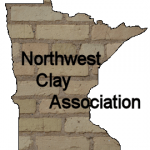
Page 240. Clayworkers Aid Art Commission. Plans for low-cost, fire-proof homes, to be compiled and distributed by the Minnesota State Art Commission to the citizens of that state, were made possible when the Northwestern Clay Association accepted the offer of Maurice I. Flagg, director of the commission at the annual banquet of the association held on January20 at the Hotel West, Minneapolis, Minn. But of far more consequence than words of acceptance, was the action of the members in voting to raise a fund to defray a part of the expense in publishing these plans, and of pledging more than half of the required amount, before the close of the banquet. Mr. Flagg was the principal speaker at the informal banquet which closed the first day’s sessions of a convention that was smaller than last year’s gathering in attendance, but not lacking in enthusiasm. In a talk that was replete with stories of interesting experiences in his travels thru the state, Mr. Flagg told of the work that his commission was doing in providing plans for model and inexpensive farm houses and city homes. The method followed in distributing these plans is rather unique and proves beyond a doubt that a man appreciates an article for which he has to pay a price much more than something which he obtains free of charge. The "model farmhouse" or city home plans of the commission are not given away, but can be obtained for the sum of $3.50, which covers the cost of complete plans and specifications, such as would ordinarily cost from fifty to one hundred dollars were they purchased from a practicing architect. The number of plans distributed under this method has reached into the millions. Mr. Flagg pointed out the fact that the distribution of these plans does not interfere with an architect’s practice because people who can afford but a few thousand dollars for a home, seldom, if ever, employ an architect. This being the case, the work of the Minnesota State Art Commission has filled a long felt want in supplying real plans for attractive homes of low-cost which are usually built without any plans or architecture.
In the past, these plans and specifications have been, almost exclusively, for frame buildings. Now, however, from the farms and small towns of the state has come a demand for fireproof homes and, anxious to give the citizens what they want, insofar as it is possible, the commission has asked the co-operation of Minnesota clay products manufacturers in the launching of a campaign for better-designed, low-cost homes of brick and hollow-tile. This suggestion, made by Mr. Flagg in an address entitled "What Two Loads of Brick Can Do," was received with considerable enthusiasm by those present and the work of raising the necessary fund started immediately. A representative of the bricklayers’ union was present, who stated that he was authorized to say that his colleagues would support the campaign with their money. The convention opened on the morning of January 20 with the usual routine business, registration, reports of the various officers and other detail matters. In the afternoon, Fred L. Schmidt, of Minneapolis, gave a stereopticon lecture on the "Economical Application of Electricity to Clay Plants," being followed by James F. Gould who took as his subject the "Treatment of Boiler Water and the Elimination of Scale." The last number of the afternoon’s program was a witnessing of tests on the crushing strengths of brick and hollow-tile and of other materials, which were made at the City Hall, under the direction of James C. Houghton, a building inspector of
Page 251. the City of Minneapolis. In the evening the banquet was held. On Friday morning, January 21, in addition to dispatching certain unfinished business of the convention, one paper was read – that of Murray B. Grover, of Minneapolis, Minn., on "Coal –When and Why." At luncheon on this day members of the association were the guests of the Minneapolis Civic and Commerce Association at which the Hon. William C. Redfield, Secretary of Foreign and Domestic Commerce gave an address, taking as his topic the foreign trade situation and the work of his department in connection therewith. Mr. Redfield mentioned the progress that was being made in the substitution of domestic clays for those formerly imported and used in the manufacture of clay products. His talk was very interesting, giving a clear, concise and complete explanation of the foreign trade situation to which so much attention is now being given in all branches of industry. On Friday afternoon, the annual election of officers was held, resulting as follows: B. Frank Pay of Mankato, president; L. G. Rose of Minneapolis, vice-president, and R. H. Smith of Minneapolis, secretary and treasurer. Following the election, came the discussion of problems found in the "Question Box," which, as usual, proved very helpful. While much was to be desired in the way of a larger attendance – about forty were present – the convention was eminently successful in view of what was accomplished. The treasury showed a substantial balance. Altogether the efforts of the retiring president, F. B. Martin, and secretary and treasurer L. G. Rose, were not without results. (Brick and Clay Record, Kenfield-Leach Company, Chicago, February 1, 1916, Volume XLVIII, Number 3)
